lock YAMAHA FZS 2015 Owners Manual
[x] Cancel search | Manufacturer: YAMAHA, Model Year: 2015, Model line: FZS, Model: YAMAHA FZS 2015Pages: 106, PDF Size: 3.92 MB
Page 18 of 106
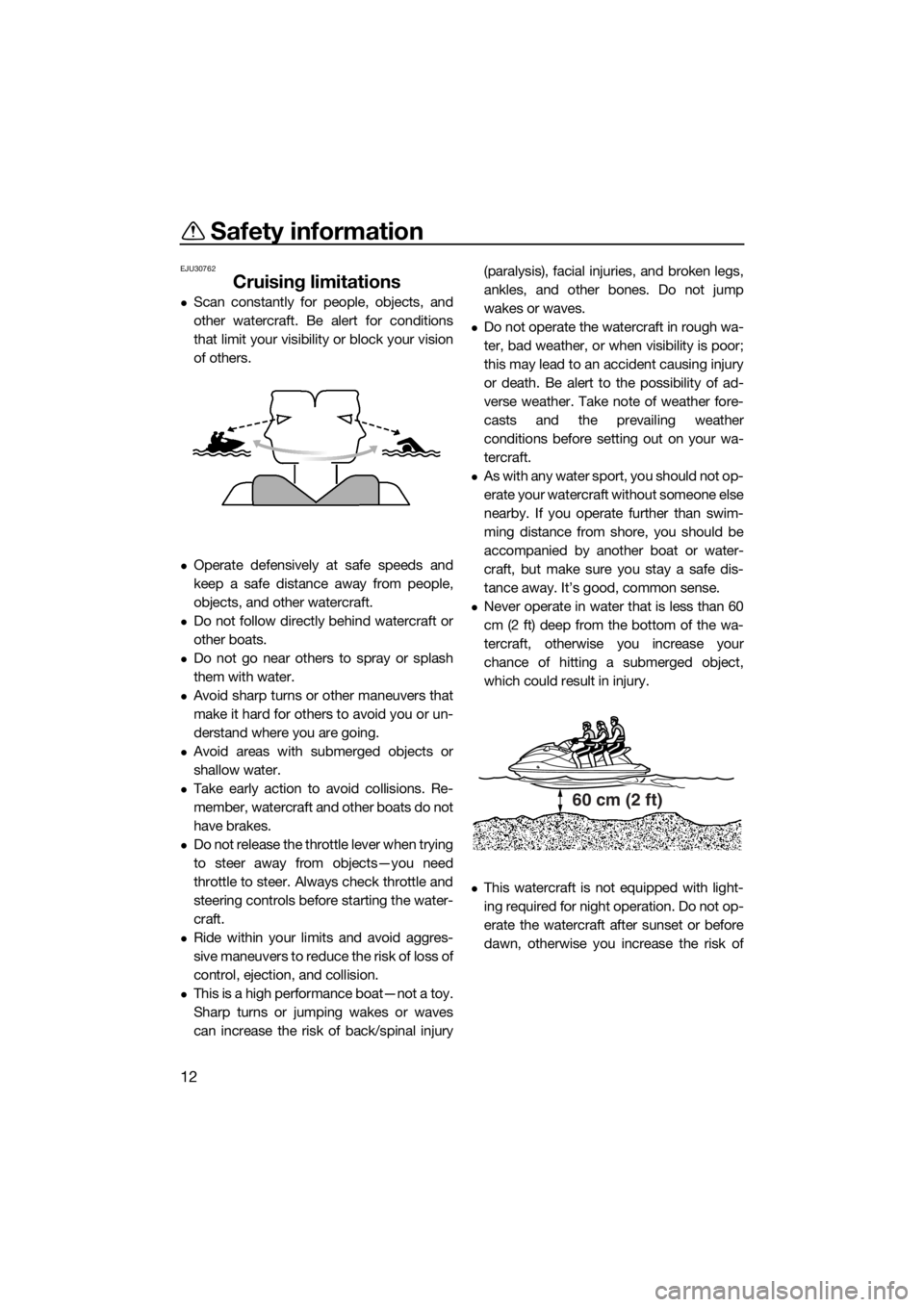
Safety information
12
EJU30762
Cruising limitations
Scan constantly for people, objects, and
other watercraft. Be alert for conditions
that limit your visibility or block your vision
of others.
Operate defensively at safe speeds and
keep a safe distance away from people,
objects, and other watercraft.
Do not follow directly behind watercraft or
other boats.
Do not go near others to spray or splash
them with water.
Avoid sharp turns or other maneuvers that
make it hard for others to avoid you or un-
derstand where you are going.
Avoid areas with submerged objects or
shallow water.
Take early action to avoid collisions. Re-
member, watercraft and other boats do not
have brakes.
Do not release the throttle lever when trying
to steer away from objects—you need
throttle to steer. Always check throttle and
steering controls before starting the water-
craft.
Ride within your limits and avoid aggres-
sive maneuvers to reduce the risk of loss of
control, ejection, and collision.
This is a high performance boat—not a toy.
Sharp turns or jumping wakes or waves
can increase the risk of back/spinal injury(paralysis), facial injuries, and broken legs,
ankles, and other bones. Do not jump
wakes or waves.
Do not operate the watercraft in rough wa-
ter, bad weather, or when visibility is poor;
this may lead to an accident causing injury
or death. Be alert to the possibility of ad-
verse weather. Take note of weather fore-
casts and the prevailing weather
conditions before setting out on your wa-
tercraft.
As with any water sport, you should not op-
erate your watercraft without someone else
nearby. If you operate further than swim-
ming distance from shore, you should be
accompanied by another boat or water-
craft, but make sure you stay a safe dis-
tance away. It’s good, common sense.
Never operate in water that is less than 60
cm (2 ft) deep from the bottom of the wa-
tercraft, otherwise you increase your
chance of hitting a submerged object,
which could result in injury.
This watercraft is not equipped with light-
ing required for night operation. Do not op-
erate the watercraft after sunset or before
dawn, otherwise you increase the risk of
60 cm (2 ft)
UF3K71E0.book Page 12 Monday, August 18, 2014 2:54 PM
Page 30 of 106
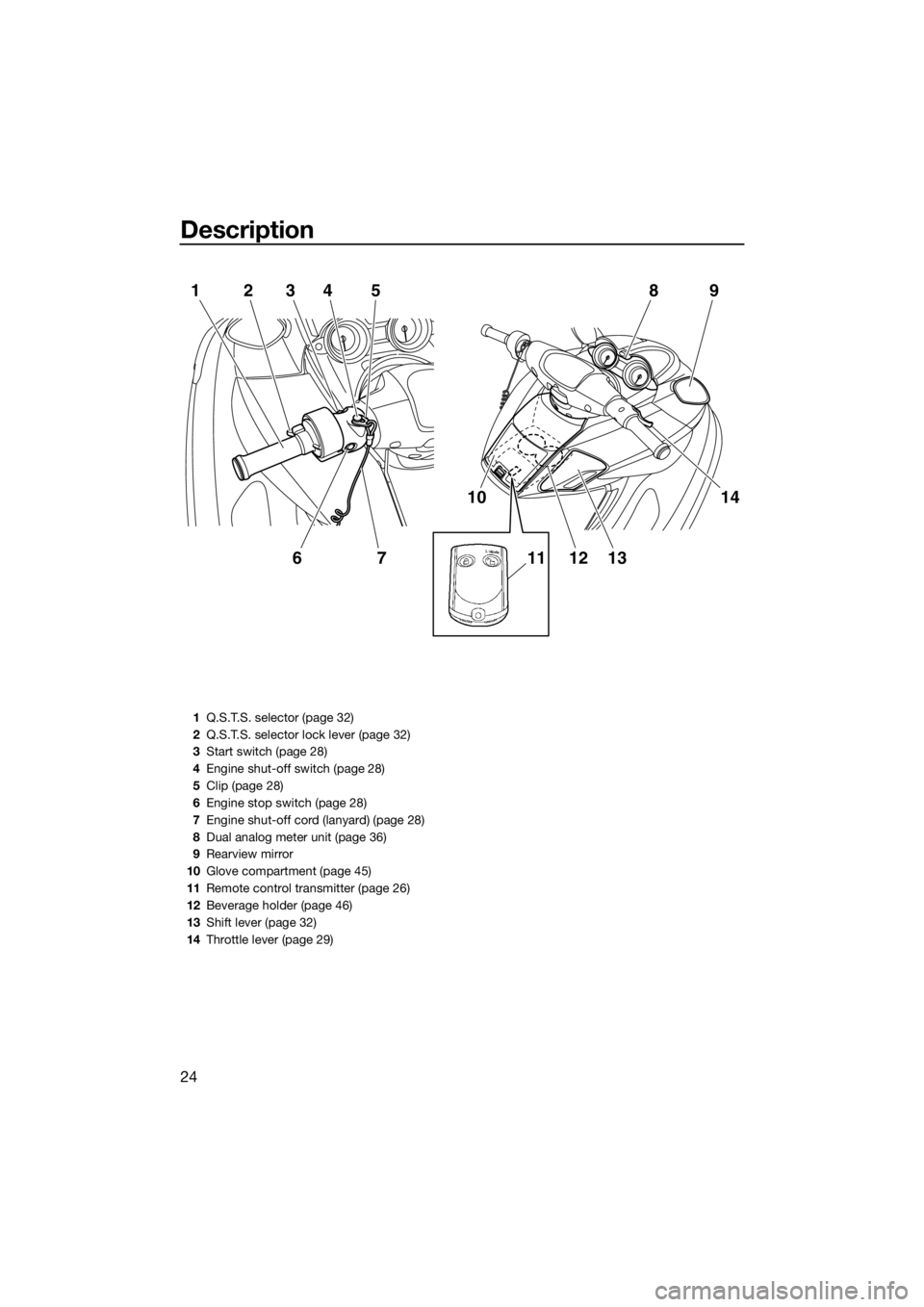
Description
24
1234
675
10
1112 1314 9 8
1Q.S.T.S. selector (page 32)
2Q.S.T.S. selector lock lever (page 32)
3Start switch (page 28)
4Engine shut-off switch (page 28)
5Clip (page 28)
6Engine stop switch (page 28)
7Engine shut-off cord (lanyard) (page 28)
8Dual analog meter unit (page 36)
9Rearview mirror
10Glove compartment (page 45)
11Remote control transmitter (page 26)
12Beverage holder (page 46)
13Shift lever (page 32)
14Throttle lever (page 29)
UF3K71E0.book Page 24 Monday, August 18, 2014 2:54 PM
Page 33 of 106

Control function operation
27
EJU31385Yamaha Security System
The Yamaha Security System functions to
help prevent unauthorized use or theft of the
watercraft. The lock and unlock modes of the
security system can be selected by operating
the remote control transmitter that is included
with this watercraft. The engine cannot be
started if the lock mode of the security sys-
tem is selected. The engine can only be start-
ed if the unlock mode is selected. (See page
26 for information on the remote control
transmitter.)
TIP:
The Yamaha Security System settings can
only be selected while the engine is stopped.
EJU37413Yamaha Security System settings
The Yamaha Security System settings will be
confirmed by the number of beeps when the
remote control transmitter is operated, and
by the “UNLOCK” indicator light of the dual
analog meter unit. (See page 36 for informa-
tion on the dual analog meter unit.)
TIP:
The beeper sounds two times for the nor-
mal operation mode or three times for the
Low RPM Mode. (See page 34 for Low
RPM Mode activation procedures.)
If the remote control transmitter is operated
while the dual analog meter unit is in the
standby state, the unit will perform the ini-tial operation, and then the setting is se-
lected.
To select the lock mode:
Push the lock button on the remote control
transmitter briefly. The beeper sounds once
and the “UNLOCK” indicator light blinks
once, then goes off. This indicates the lock
mode is selected.
To select the unlock mode:
Push the “L-Mode” (unlock) button on the re-
mote control transmitter briefly. The beeper
sounds two or three times and the “UN-
LOCK” indicator light blinks two or three
times, then comes on. This indicates the un-
lock mode is selected.
Number of
beepsYamaha Security
System mode“UN-
LOCK” in-
dicator
light
Lock Goes off
Unlock
(normal operation
mode)Comes
on
Unlock
(Low RPM Mode)Comes
on
1Lock button
2“UNLOCK” indicator light
1“L-Mode” (unlock) button
2“UNLOCK” indicator light
1
2
L-Mode1
2
UF3K71E0.book Page 27 Monday, August 18, 2014 2:54 PM
Page 35 of 106
![YAMAHA FZS 2015 Owners Manual Control function operation
29
will not start. Also, the starter motor could
be damaged.
[ECJ01041]
The engine will not start under any of the fol-
lowing conditions:
Lock mode of the Yamaha Securi YAMAHA FZS 2015 Owners Manual Control function operation
29
will not start. Also, the starter motor could
be damaged.
[ECJ01041]
The engine will not start under any of the fol-
lowing conditions:
Lock mode of the Yamaha Securi](/img/51/50196/w960_50196-34.png)
Control function operation
29
will not start. Also, the starter motor could
be damaged.
[ECJ01041]
The engine will not start under any of the fol-
lowing conditions:
Lock mode of the Yamaha Security System
has been selected. (See page 27 for
Yamaha Security System setting proce-
dures.)
Clip is removed from the engine shut-off
switch.
Throttle lever is squeezed.EJU31212Throttle lever
The throttle lever increases the engine speed
when the lever is squeezed.
The throttle lever returns automatically to its
fully closed (idle) position when released.
EJU31262Steering system
By turning the handlebars in the direction you
wish to travel, the angle of the jet thrust noz-
zle is changed, and the direction of the water-
craft is changed accordingly.
Since the strength of the jet thrust determines
the speed and degree of a turn, throttle must
always be applied when attempting a turn,
except at trolling speed.
This model is equipped with the Yamaha En-
gine Management System (YEMS) that in-
cludes an off-throttle steering (OTS) system.
It will activate at planing speeds should you
attempt to steer the watercraft after releasing
the throttle lever. The OTS system assists in
turning by continuing to supply some thrust
while the watercraft is decelerating, but you
can turn more sharply if you apply throttle
while turning the handlebars. The OTS sys-
tem does not function below planing speeds
or when the engine is off. Once the engine
slows down, the watercraft will no longer turn
1Start switch
1Throttle lever
1
1
1Handlebar
2Jet thrust nozzle
1
2
UF3K71E0.book Page 29 Monday, August 18, 2014 2:54 PM
Page 36 of 106
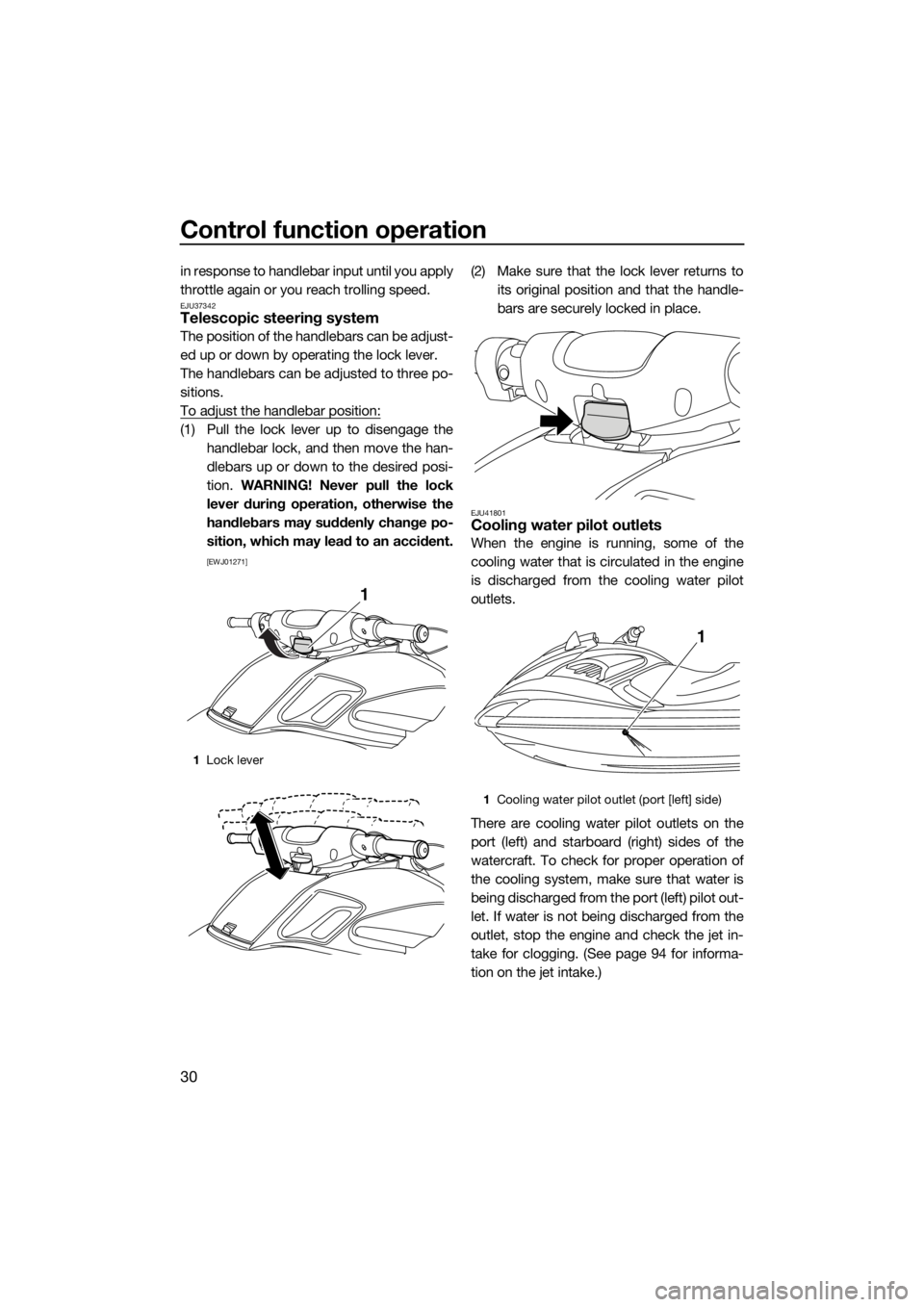
Control function operation
30
in response to handlebar input until you apply
throttle again or you reach trolling speed.
EJU37342Telescopic steering system
The position of the handlebars can be adjust-
ed up or down by operating the lock lever.
The handlebars can be adjusted to three po-
sitions.
To adjust the handlebar position:
(1) Pull the lock lever up to disengage the
handlebar lock, and then move the han-
dlebars up or down to the desired posi-
tion. WARNING! Never pull the lock
lever during operation, otherwise the
handlebars may suddenly change po-
sition, which may lead to an accident.
[EWJ01271]
(2) Make sure that the lock lever returns to
its original position and that the handle-
bars are securely locked in place.
EJU41801Cooling water pilot outlets
When the engine is running, some of the
cooling water that is circulated in the engine
is discharged from the cooling water pilot
outlets.
There are cooling water pilot outlets on the
port (left) and starboard (right) sides of the
watercraft. To check for proper operation of
the cooling system, make sure that water is
being discharged from the port (left) pilot out-
let. If water is not being discharged from the
outlet, stop the engine and check the jet in-
take for clogging. (See page 94 for informa-
tion on the jet intake.)
1Lock lever
1
1Cooling water pilot outlet (port [left] side)
1
UF3K71E0.book Page 30 Monday, August 18, 2014 2:54 PM
Page 39 of 106

Watercraft operation
33
the vertical angle of the jet thrust nozzle,
which adjusts the trim angle of the watercraft.
There are 5 positions: neutral, 2 bow-down
positions (a) and (b), and 2 bow-up positions
(c) and (d).
Bow-down positions (a) and (b)
The bow will go down, causing the trim angle
to decrease.
Vertical movement of the bow will be reduced
and the watercraft will get up on plane more
quickly when accelerating.
Bow-up positions (c) and (d)
The bow will go up, causing the trim angle to
increase.
There is less water resistance, therefore,
straight-ahead acceleration is enhanced.TIP:
The watercraft performance characteristics
according to the trim angle change depend-
ing on the operating conditions.
To change the trim angle:
(1) Reduce engine speed to less than 3000
r/min.
(2) Squeeze the Q.S.T.S. selector lock lever,
and then turn the Q.S.T.S. selector to the
desired position. NOTICE: Do not turn
the Q.S.T.S. selector while operating
the watercraft at an engine speed of1Q.S.T.S. selector
(c)
(d)(a)
(b)
(b)
(a) (d)
(c)
1
(d)
(c)
(b)N
(a)
UF3K71E0.book Page 33 Monday, August 18, 2014 2:54 PM
Page 40 of 106
![YAMAHA FZS 2015 Owners Manual Watercraft operation
34
3000 r/min or more, otherwise dam-
age could occur to the Q.S.T.S.
[ECJ00014]
(3) Release the lock lever, and then make
sure that the Q.S.T.S. selector is securely
locked in p YAMAHA FZS 2015 Owners Manual Watercraft operation
34
3000 r/min or more, otherwise dam-
age could occur to the Q.S.T.S.
[ECJ00014]
(3) Release the lock lever, and then make
sure that the Q.S.T.S. selector is securely
locked in p](/img/51/50196/w960_50196-39.png)
Watercraft operation
34
3000 r/min or more, otherwise dam-
age could occur to the Q.S.T.S.
[ECJ00014]
(3) Release the lock lever, and then make
sure that the Q.S.T.S. selector is securely
locked in place.
EJU40001
Watercraft operation modes
EJU42760Low RPM Mode
The Low RPM Mode is a function that limits
the maximum engine speed to approximately
60% of the maximum engine speed in the
normal mode.
The Low RPM Mode can only be activated
and deactivated by operating the remote
control transmitter that is included with this
watercraft. (See page 26 for information on
the remote control transmitter.)
TIP:
The Low RPM Mode can only be activated
when the engine is stopped in the unlock
mode of the Yamaha Security System.
Activating and deactivating the Low RPM
Mode
Activation of the Low RPM Mode will be con-
firmed by the number of beeps when the re-
mote control transmitter is operated, and by
the “L-MODE” indicator light of the dual ana-
log meter unit. (See page 36 for information
on the dual analog meter unit.)
1Q.S.T.S. selector
2Q.S.T.S. selector lock lever
1Remote control transmitter
UF3K71E0.book Page 34 Monday, August 18, 2014 2:54 PM
Page 41 of 106
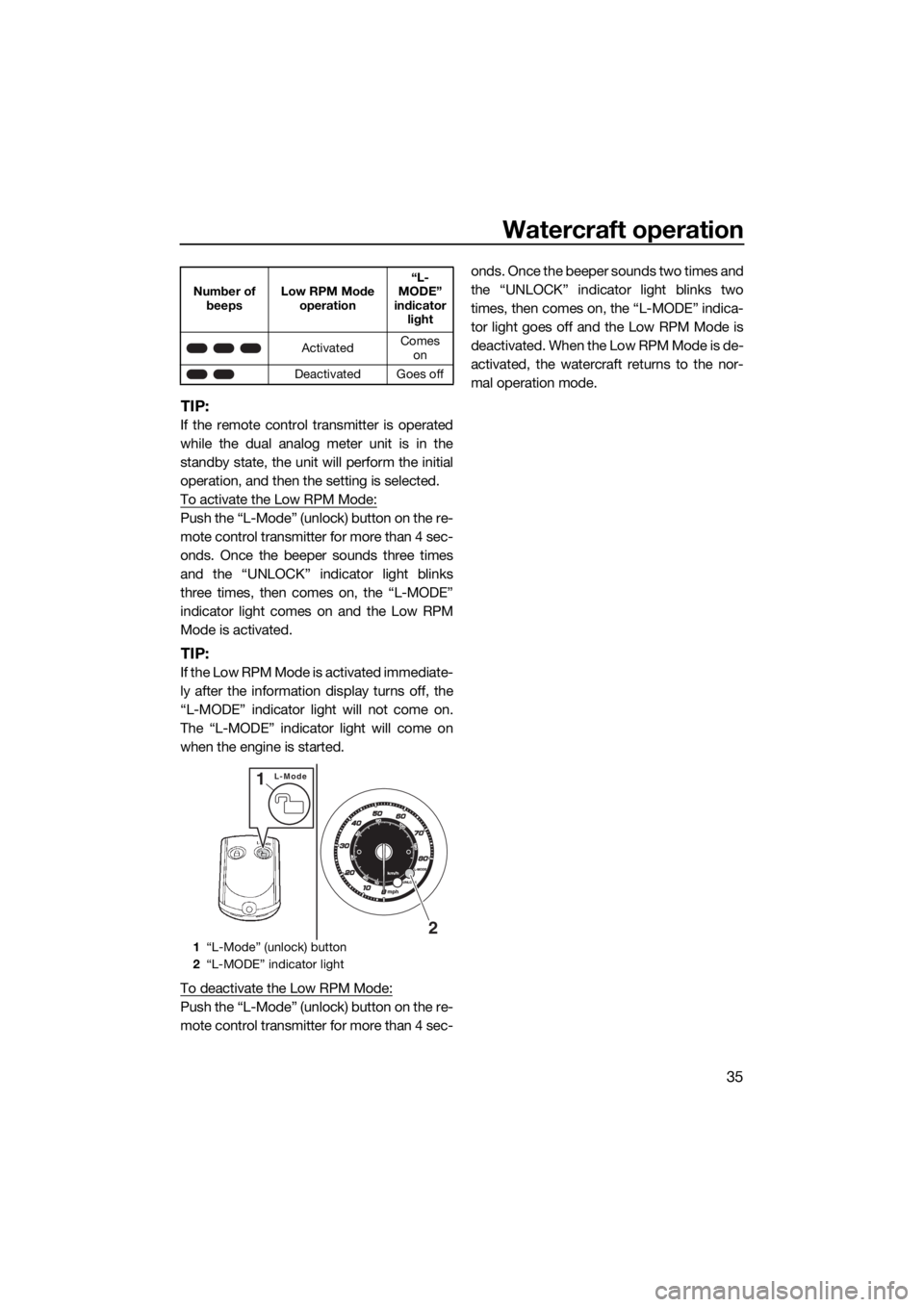
Watercraft operation
35
TIP:
If the remote control transmitter is operated
while the dual analog meter unit is in the
standby state, the unit will perform the initial
operation, and then the setting is selected.
To activate the Low RPM Mode:
Push the “L-Mode” (unlock) button on the re-
mote control transmitter for more than 4 sec-
onds. Once the beeper sounds three times
and the “UNLOCK” indicator light blinks
three times, then comes on, the “L-MODE”
indicator light comes on and the Low RPM
Mode is activated.
TIP:
If the Low RPM Mode is activated immediate-
ly after the information display turns off, the
“L-MODE” indicator light will not come on.
The “L-MODE” indicator light will come on
when the engine is started.
To deactivate the Low RPM Mode:
Push the “L-Mode” (unlock) button on the re-
mote control transmitter for more than 4 sec-onds. Once the beeper sounds two times and
the “UNLOCK” indicator light blinks two
times, then comes on, the “L-MODE” indica-
tor light goes off and the Low RPM Mode is
deactivated. When the Low RPM Mode is de-
activated, the watercraft returns to the nor-
mal operation mode.
Number of
beepsLow RPM Mode
operation“L-
MODE”
indicator
light
ActivatedComes
on
Deactivated Goes off
1“L-Mode” (unlock) button
2“L-MODE” indicator light
L-Mode1
2
UF3K71E0.book Page 35 Monday, August 18, 2014 2:54 PM
Page 42 of 106
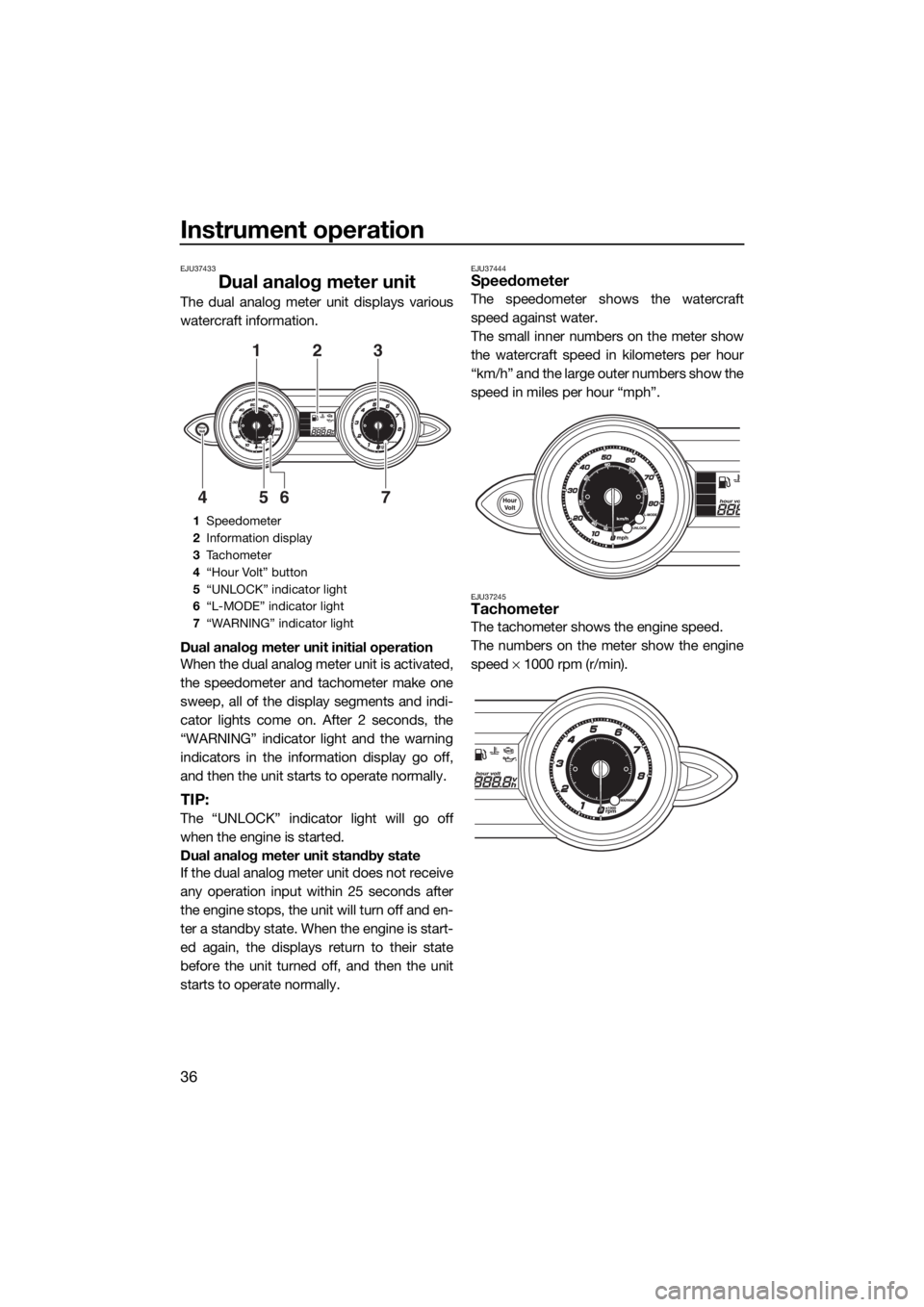
Instrument operation
36
EJU37433
Dual analog meter unit
The dual analog meter unit displays various
watercraft information.
Dual analog meter unit initial operation
When the dual analog meter unit is activated,
the speedometer and tachometer make one
sweep, all of the display segments and indi-
cator lights come on. After 2 seconds, the
“WARNING” indicator light and the warning
indicators in the information display go off,
and then the unit starts to operate normally.
TIP:
The “UNLOCK” indicator light will go off
when the engine is started.
Dual analog meter unit standby state
If the dual analog meter unit does not receive
any operation input within 25 seconds after
the engine stops, the unit will turn off and en-
ter a standby state. When the engine is start-
ed again, the displays return to their state
before the unit turned off, and then the unit
starts to operate normally.
EJU37444Speedometer
The speedometer shows the watercraft
speed against water.
The small inner numbers on the meter show
the watercraft speed in kilometers per hour
“km/h” and the large outer numbers show the
speed in miles per hour “mph”.
EJU37245Tachometer
The tachometer shows the engine speed.
The numbers on the meter show the engine
speed × 1000 rpm (r/min).
1Speedometer
2Information display
3Tachometer
4“Hour Volt” button
5“UNLOCK” indicator light
6“L-MODE” indicator light
7“WARNING” indicator light
123
7 6 5 4
UF3K71E0.book Page 36 Monday, August 18, 2014 2:54 PM
Page 47 of 106
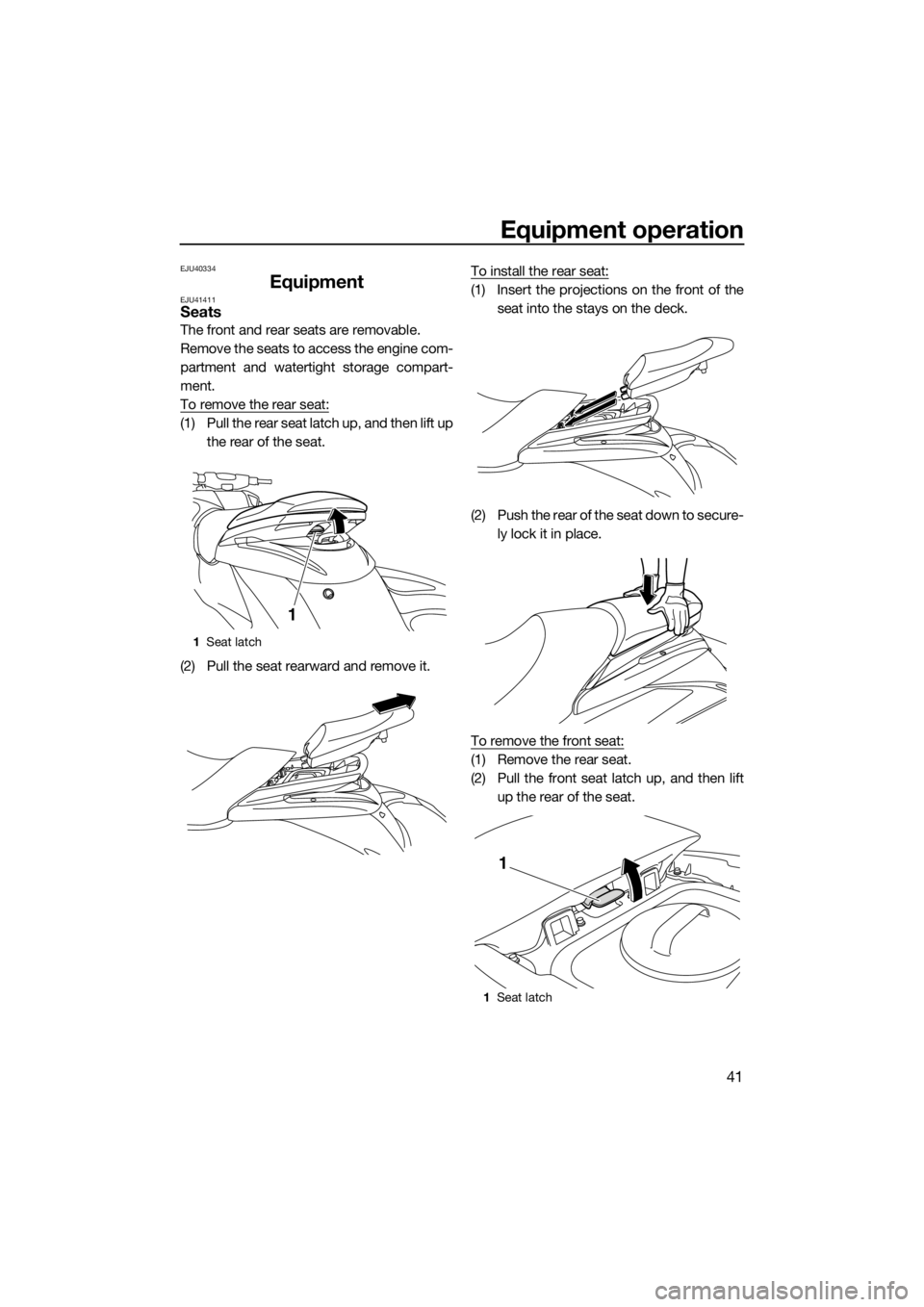
Equipment operation
41
EJU40334
EquipmentEJU41411Seats
The front and rear seats are removable.
Remove the seats to access the engine com-
partment and watertight storage compart-
ment.
To remove the rear seat:
(1) Pull the rear seat latch up, and then lift up
the rear of the seat.
(2) Pull the seat rearward and remove it.To install the rear seat:
(1) Insert the projections on the front of the
seat into the stays on the deck.
(2) Push the rear of the seat down to secure-
ly lock it in place.
To remove the front seat:
(1) Remove the rear seat.
(2) Pull the front seat latch up, and then lift
up the rear of the seat.
1Seat latch
1
1Seat latch
1
UF3K71E0.book Page 41 Monday, August 18, 2014 2:54 PM